PVS Newsletter / Spring 2001
Message from Executive Director Elisa Yadao
Aloha!
I hope you enjoy this inaugural edition of what we plan to be regular newsletters from the Polynesian Voyaging Society. As you'll read in these pages, it has been quite a year for us since completing the voyage to Rapa Nui.
None of what we've accomplished would have been possible without the support of folks like you. We offer our heartfelt thanks for all of your k-okua over the past many years.
While the focus of this newsletter is primarily on things that have already happened, there are many exciting things on our horizon. Hokule‘a is currently on a sail around the state and you'll read about the wonderful response the canoe has received on the neighbor islands. We are hard at work on our strategic plan, which continues to focus on wavs to take the lessons learned on the canoe and translate them into ways to ni7alama Hawai'i and make our island home healthy and safe. Plans are now underway for the PVS fundraiser to be held later this year. Entitled Ho‘oilina Mau, or Enduring Legacy, we will pay honor to the men and women who sailed Hokule‘a to and from Tagiti on her maiden voyage in 1976.
We will also pay tribute to the great teachers in PVS who have contributed mightily to our work. These individuals are also profiled in this edition of our newsletter. They include: Wright Bowman Sr., master canoe builder, Wally Froiseth, veteran crewmember, Kawika Kapahulehua, captain of the 1976 voyage, Will Kyselka, astronomer, Mau Piailug, master navigator and Myron Thompson, president of the Polynesian Voyaging Society.
Meanwhile, I hope you enjoy reading about what we're doing, where we've been and where we hope to go. Again, mahalo for your support of PVS.
Voyaging in the New Millenium
For many, the year 2000 held memories of the past, while ushering in new hopes and dreams for the future. For the Polynesian Voyaging Society (PVS), the year 2000 was a celebration of a quarter-century of visions seen, hopes believed, and dreams achieved.
From March 1975 to March 2000, thousands watched and took part as Hokule‘a, the first traditional Polynesian voyaging canoe to sail in 600 years, sailed more than 90,000 nautical miles or nearly four times around the globe. All of this began with a dream, a vision. Three visionaries, Dr. Ben Finney, Herb Kane and Tommy Holmes founded the Polynesian Voyaging Society in 1973 to demonstrate that the ancient Polynesians sailed their double-hulled canoes using non-instrument navigation to settle their vast nation. How their dream has grown in the quarter century that Hokule‘a has been sailing.
In 1973, there was only one known deep-sea navigator. Today, there are nine with more in training. Six voyaging canoes have been built, and several more are under construction. Hokule‘a, which means “Star of Gladness” in Hawaiian, has reached every point of the Polynesian triangle and has also traveled to the West Coast of the United States, bridging communities, renewing cultures and creating opportunities for growth and learning.
Through these voyages of exploration and discovery, the Polynesian Voyaging Society has sought to celebrate the importance of history and heritage, and honor the values which are fundamental to sailing on the canoe. PVS supports the vision of Malama Hawa‘ii - that Hawai‘i, our special island home, is a place where the people, land and sea are cared for and communities are healthy and safe.
For the Voyaging Society, the new century was welcomed with a miraculous and once improbable voyage to Rapa Nui, one of the most isolated inhabited islands in the world.

As Hokule‘a and her crew sailed east, navigators Nainoa Thompson, Chad Baybayan, and Bruce Blankenfeld, used the stars, ocean swells, and favorable winds to guide her along. Following a successful and swift 19-day, 1,450 mile voyage from the tiny island of Mangareva, crew member Max Yarawamai sighted Rapa Nui through a small hole in a wall of clouds. Hokule‘a’s visit to the island brought a renewal of culture, environment and health for Rapa Nui. The completion of the voyage was bittersweet - reaching the final point in the Polynesian triangle brought a feeling of pride, but also a feeling of sadness in the closing of this chapter of deep sea voyaging.
A Homecoming Celebration, honoring the past 25 years of achievement by PVS and the safe return of Hokule‘a from its epic 10 month voyage to Rapa Nui, was held on March 12. The event began with the arrival of the voyaging canoes Hokule‘a, Hawai'iloa, Makali'i, and Mo'olele in the early morning, followed by various ceremonial activities, including chants, songs and dances, to welcome the crew in the traditional fashion. A Ho'olaule'a celebration followed, with food, exhibits and entertainment by some of Hawaii's finest performers.
During this homecoming month, Governor Ben Cayetano proclaimed Hokule‘a a State Treasure. "Hokule‘a has become a living treasure to the people of Hawai'i," said Governor Cayetano. "Her crews have traveled more than a hundred thousand miles throughout the Polynesian triangle, and she has stimulated great pride among all the people of our islands. I urge citizens to visit the Hawaii Maritime Center to pay tribute to this beloved symbol of our Hawaiian heritage." Hokule‘a is the first ever proclaimed State Treasure in the State of Hawaii.
PVS held a fundraising event at the Hawai'i Convention Center on April 18, 2000. The event celebrated past achievements, while highlighting current and ongoing programs such as the Statewide Sail, the Environment and Ocean Education Programs, as well as the Ocean Learning Center. Governor Benjamin Cayetano, Senator Daniel Akaka and Senator Daniel Inouye were honorary chairs. Entertainment included performances by the Kamehameha Schools Concert Glee Club, the Brothers Cazimero, Paiea and 'Elua K-ane. PVS wishes to thank the Campbell Family and the many others whose donations have helped further the mission of PVS.
Hokule‘a’s Millenium Statewide Sail / 2000-2001
In September of 2000, Hokule‘a set sail on another significant journey - this time to visit dozens of communities around the State of Hawai'i and to bring Hokule‘a’s adventures, stories and educational experiences closer to home. This nine-month Statewide Sail, entitled "Our Islands, Our Canoe," will bring hands-on learning experiences to students and their families all over the islands.

In the first four months of the voyage, thousands of students, teachers and community members have met Hokule‘a and her crew. The sail is also an opportunity for the crew to express their gratitude and appreciation to the hundreds of thousands of people who supported the Polynesian Voyaging Society and its efforts in the last 25 years.
As an educational and community-based program, the statewide sail is a joint effort of PVS, the Hawaii Millennium Commission, The Bernice Pauahi Bishop Museum and Malama Hawaii - a consortium of individuals and organizations across the State, working together to care for Hawaii. Through sharing voyaging traditions and values, the statewide sail is a contribution to Hawai'i's communities and their efforts to build a healthy and sustainable future.
On September 22, Hokule‘a left Honolulu bound for Nawiliwili, Kaua‘i, the first stop of the statewide sail.
After a successful overnight journey across the Ka'ie'ie Channel, led by Captain Dennis Chun and student navigator Lei Wann, Hokule‘a reached her destination.

Captain Dennis Chun and student navigator Lei Wann
The statewide sail is an opportunity for newer crewmembers to learn from experienced crewmembers and to perpetuate the traditions of Polynesian voyaging and navigation. Captain Chun notes, "Growth is seen when the students take what they have learned in the classroom and apply it out on the ocean. There is a feeling of excitement when they say, 'I think this star should be rising,' and when it does, they can proudly say, 'We're on course!"'
Over 551 students, 33 teachers, and 40 volunteers came to visit Hokule‘a and her crew during the first week at Nawiliwili. Crewmembers shared their experiences on Hokule‘a, teaching students how the e operates, its relationship to culture and the environment, and the values which enabled ancient Hawaiians to survive on limited resources. Student navigator Lei Wann, whose interest in sailing was sparked at age five bv her uncle, long time crewmember, Kimo Lyman, says, "I enjoyed seeing the kids' excitement and their reactions to the canoe. They all wanted to know how they could get involved!"
During the first two weeks of October, Hokule‘a docked at 'Ele'Ele (Port Allen) on the west side of Kaua'i. Tours of the canoe were given to over 1,109 school children and 55 teachers, while hundreds more paid a visit to Hokule‘a to "talk story" with the crew. Wann comments, "Everybody comes together during the sail, everyone gets involved. People share their food, the h-alau share their dances and there is a real sense of unity."
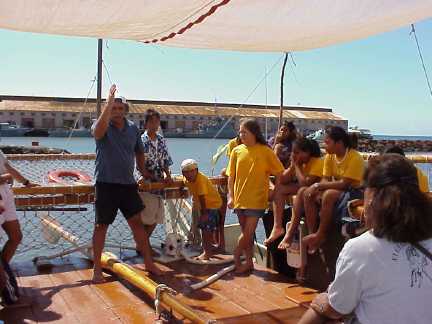
Veteran Kaua‘i crew member John Kruse talking with students at ‘Ele‘ele
On October 22, the crew completed the leg to Hanalei on the North Shore of Kauai. Volunteers gave presentations and lectures to people in the community as well as school children.
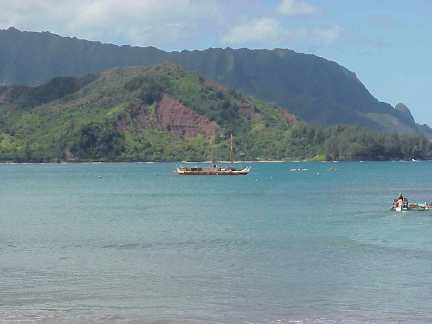
Hokule‘a in Hanalei
The children were so excited by Hokule‘a, many of them returned with their families to revisit the canoe after school. "A re-awakening takes place when the community recognizes the value of Polynesian voyaging and how it applies to their community. The issues dealt with on the canoe - limited resources, community cohesiveness and the need for cooperation - are the same issues dealt with on land," says Captain Chun.
Special ceremonies took place as the canoe bid farewell to Kauai at the end of the week. Hokule‘a truly touched the people of this island, giving them a sense of pride in their culture and the knowledge of how to perpetuate it within their communities.

Departure Ceremony
Following a three day voyage from Kaual, Hokule‘a arrived in Hilo Bay on the Big Island of Hawai'l on October 31. Met by the rains and floods that hit the Big Island in early November, the crew made necessary adjustments by bringing Hokule‘a to the people. Photos, equipment, and stories were brought to the classrooms until the rains subsided and the school children could visit the canoe at its dock.

Students visited in the Hilo rain.

Kamehemeha Schools students came on a sunnier day.
On the way to Miloli‘i, the crew was amazed at the sight of the lava flowing into the ocean from Kilauea. Kaliko Amona, who had the opportunity to view this awesome phenomenon said, "The most amazing part of the sail was getting to see the lava at Kilauea pouring into the ocean, creating more land. I wondered if that sight touched the first voyagers to see the volcano in the same way."
Hokule‘a continues on the Statewide Sail, visiting Maui, Lana‘i, Kaho‘olawe, Moloka‘i and O‘ahu. The Polynesian Voyaging Society invites people in these communities to take part in the events on their islands.
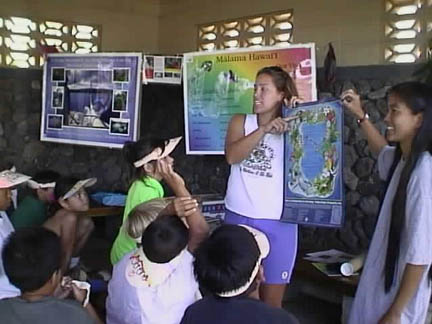
Kaliko doing a presentation on Maui
- Sept.22-Sept.23: Honolulu to Nawiliwili, Kaua‘i
- Sept.23-Sept.30: Nawiliwili, Kaua‘i
- Oct.1-Oct. 15: Port Allen, Kaua‘i
- Oct.15-Oct.21: Nawiliwili, Kaua‘i
- Oct.21-Oct.27: Hanalei, Kaua‘i
- Oct.27-Oct.28: Hanalei to Honolulu
- Oct.30-Nov.11: Hilo, Hawai‘i
- Nov.11-Nov.14: Miloli‘i, Hawa‘i
- Nov.14-Nov.16: Honaunau, Hawai‘i
- Nov.16-Dec. 1: Keauhou, Hawai‘i
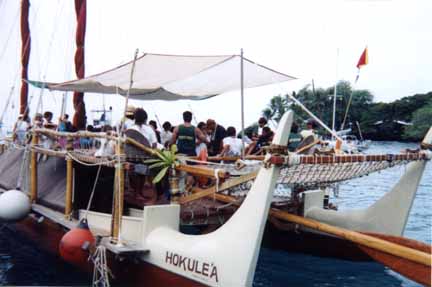
Canoe tours at Keauhou
- Dec.2: Honokohau, Hawai‘i
- Dec.3-Dec.10: Kawaihae, Hawai‘i (via Kaupulehu)
- Dec.10-Dec.11: Maunalani Resort, Hawai‘i
- Dec.11-Dec.16: Kawaihae, Hawai‘i
- Dec.16-Dec.17: Lahaina, Maui
- 7Dec.17-jan.19: O‘ahu, Winter Vacation
- Jan-9-Jan.12: Hawai‘i Maritime Center, Honolulu District Tours
- Jan.16-jan.19: Hawai‘i Maritime Center, East 0ahu District Tours
- Jan.20-Jan.26: Lana‘i
- Jan.27-Feb.11: Lahaina, Maui
- Feb.11-Feb.25: Ma‘alaea, Maui
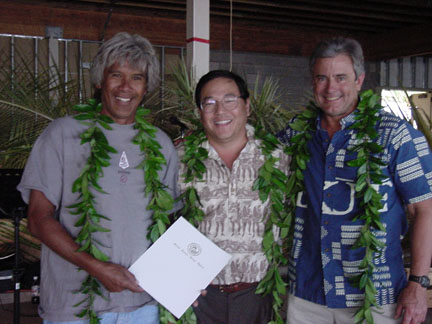
Snake Ah Hee with Maui mayor James “Kimo” Apana declaring 2001 “The Year of Hokule‘a.”
- Feb.25-Mar.18: Kaunakakai, Molokai
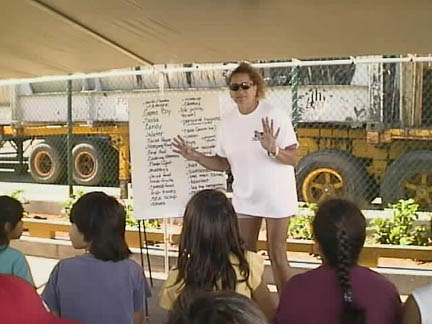
Crew member Penny Martin doing her presentation on Moloka‘i.
- Mar.18-Mar.24: Hana, Maui
- Mar.25-Apr. 1. Maunalua Bay, O‘ahu
- Apr.2-Apr.3: Moku o Loe, O‘ahu
- Apr.4-Apr.21: Kualoa, O‘ahu
- Apr.21-Apr.28: Kahana, O‘ahu
- Apr.28-May 5: Hale'iwa, 0ahu
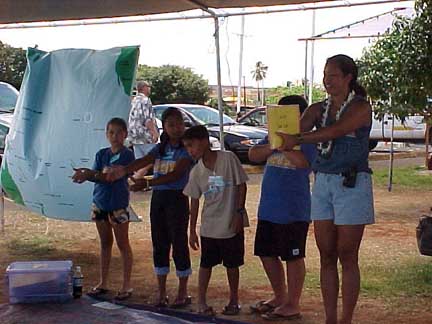
Shantell Ching leading a navigation workshop at Hale‘iwa
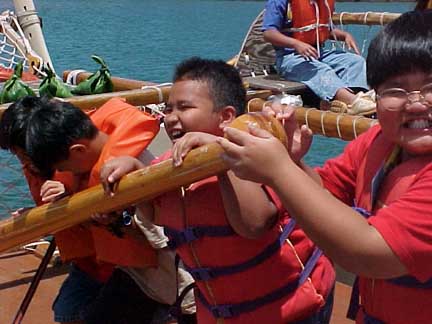
Mililani students try out the steering paddle
- May 5-May 13: Poka'i Bay, O‘ahu
- May 13-May 20: Ko'olina,O‘ahu
- May 20-Summer: Hawai‘i Maritime Center
From Generation to Generations
The Polynesian Voyaging Society owes its success to the men, women and children who have made us a part of their lives. PVS would like to highlight some of these individuals as a mahalo.
Myron "Pinky" Thompson
For an organization to be successful, there must be strong leadership and powerful vision. Myron "Pinky" Thompson, president of the Polynesian Voyaging Society is the epitome of such leadership. A kind, unassuming man, he leads without dominating, empowering others to leadership. Yet, in his quiet way, Thompson demands the commitment and dedication required for the organization to uphold its vision.

Myron "Pinky" Thompson Star Bulletin Archives
The origin of this vision stems from his past. Following the bombing of Pearl Harbor in 1941, the young Thompson felt an obligation to fight for his country, as a Hawaiian and an American. While fighting in World War II, Thompson was badly injured in the forests of France. The near-fatal wound kept him in a military hospital for two years. It was during his time in the hospital that Thompson's vision began to take form. He saw Hawai'i's unique culture in danger of being lost.
Thompson then made a life-long commitment to return to his island home, where he would seek to restore a sense of pride in the people of Hawai'i and to help revive the Hawaiian culture.
In 1979, when Thompson stepped into leadership as the president of PVS, he brought to the table several requirements necessary for the organization to be successful. A clear and powerful vision needed to be established to unify the voyaging community. "He recognized that Hokule‘a was a powerful tool to rebuild Hawaiian culture and pride," says Nainoa, son of Thompson and navigator of Hokule‘a. By keeping this focus, PVS and the community could understand that the purpose of voyaging was not only to each a destination, but to achieve a higher goal.
Vision is achieved through commitment, something Thompson continually exhibited as a leader of PVS. A successful voyage required individuals who were trained and dedicated. "In his mind, 95% of success vas determined before you went to sea - through preparation, training and commitment. He demanded that everyone know where they were going, why, and how they were going to get there," says Nainoa about his father, who Nainoa says is his hero and inspiration.
The Polynesian Voyaging Society offers heartfelt thanks and appreciation to Myron "Pinky" Thompson for his dedication throughout the years. His leadership and guidance in the voyaging community paved the way for educational programs which reach out to younger generations and community building initiatives which foster strong leadership and support expansive vision.
Mau Piailug
How does one become a master navigator? For Mau Piailug, born and raised on ,atawal, a remote island in Micronesia, navigation was his life calling. As an ipprentice to his grandfather, Mau's training began at age four. He did not learn f i-om textbooks or maps or instruments. Instead, he was held in the tide pools so he could feel the motion of the waves, and experience the movement of the wind. Mau spent many hours studying the stars, memorizing the information he learned through chants and from oral tradition.

Mau. Photo by Monte Costa
In 1978, Nainoa Thompson flew to Micronesia, in search of not only Mau the navigator, but Mau the teacher. Until then, Nainoa had studied astronomy and modem science to learn the art of navigation. He knew that before he could successfully navigate a voyage to Tahiti, he must also gain a deeper understanding of traditional navigation.
When Mau agreed to accept Nainoa as his apprentice, he left Micronesia and came to Hawai'i with a clear purpose in mind: to share his knowledge of voyaging and navigation with people outside his own culture. "He is one of the few traditional master navigators willing and able to reach beyond his culture to ours," says Nainoa.
Mau taught Nainoa to steer by the stars and ocean swells, to predict the weather by the shapes and colors of the clouds, and to use the flight path of birds to find land. "Mau turns the clues from the heavens and ocean into practical knowledge. He could be lying inside the hull of the canoe and feel the different wave patterns as they came to the canoe and be able to tell the canoe's direction."
In 1980, Nainoa and the crew of Hokule‘a successfully voyaged to Tahiti, making Nainoa the first Hawaiian to navigate a voyaging canoe in more than 600 years. Mau's willingness to teach others the art of traditional voyaging has since opened the doors for a generation of young navigators to emerge. "I believe that Mau's genius is not just in being a navigator, but that he is able to cross great cultural bridges and help us find our way at sea. His teaching has become his legacy."
Kawika Kapahulehua
For many sailors, the destination is the goal. For Kawika Kapahulehua, the journey was the reward. It was 1948 when 18-year-old Kapahulehua started working on the Manu Kai catamaran. Working seven days a week, he learned everything he could about a sailboat. When someone was looking for him, they would find him in the usual place - on the boat. His friend and employer, Woody Brown, told Kapahulehua "I'll teach you everything I know. Someday, someone will ask you, 'Do you know how to sail a double hulled canoe?' and you can say with authority, ves, I do."' Twenty-eight years later, Kapahulehua found himself aboard Hokule‘a, the captain of her maiden voyage to Tahiti.
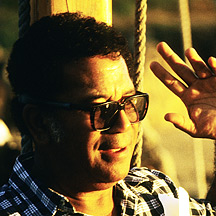
Kawika, c. 1976
Kapahulehua had met the criteria for captain: a Polynesian, able to speak and understand the Hawaiian language, with knowledge and experience in sailing. For nearly ten years prior, he had taught and participated in competitive catamaran racing in Califomia, while working for Western Airlines. The experience would prepare him for the voyage of a lifetime. "I wanted to take Hokule‘a to Tahiti and return the canoe in better condition than when she had left." The safety of the crew and the canoe were of his utmost concern. When Hokule‘a made landfall on Mataiva, an atoll in the Tuamotu islands, Kapahulehua recalls the welcome they received. "While on Mataiva, we took the opportunity to get cleaned up before going on to Tahiti. The women took our dirty clothes as souvenirs, washed them and spelled out ‘Hokule‘a came to Mataiva’ on the wall as we left!"
Kapahulehua, who spent twelve years of his childhood on Ni'ihau, taught himself English by speaking with the tourists when he moved to Honolulu. "I was told I was like a coconut: brown on the outside but when I opened my mouth, I spoke like a haole." A retired Delta Airlines employee, Kapahulehua now teaches Hawaiian language at the University of Hawai'i. "I enjoy working with my students. It's time to give back and share what I've learned."
When reflecting on what he is most grateful for, Kapahulehua says, “The experience to sail. Somewhere along the line, I was already chosen for that. There was always a voice saying, 'You can do it. No problem. Do it.’” He sees the value in teaching young people to surf, swim and sail. "By teaching them these things, you are instilling the values of their ancestors."
Will Kyselka
In an ocean as vast as the Pacific, finding islands by way of human navigation is no task. Nainoa Thompson knew that the key to finding islands in the Pacific was knowledge of the stars. “The stars give you direction. They are like a compass, continually changing. When stars don't appear, you use other clues. It's the wayfinder’s task to discern meaning in those clues." These are the words of Will Kyselka, geologist, author, and retired associate professor at the University of Hawai‘i.
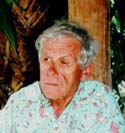
Will
In 1977, Thompson met with Kyselka at the Bishop Museum Planetarium in Honolulu where they spent hours studying the movement of the stars. "I worked with Nainoa, giving him the star knowledge he needed. From there, he went on to develop his own unique wayfinding system."
Kyselka found himself fascinated with how the ancient Polynesians were able to stay oriented as they sailed the Polynesian Triangle. "What they did was remarkable: finding tiny islands over vast oceanic distances, without the use of instruments. Somebody had to show that it is possible to reconstruct an ancient craft and generate a system of wayfinding to maintain orientation. They (the Polynesian Voyaging Society) demonstrated the capability of the Hokule‘a and the ability of the navigator to do this."
On the 1980 Voyage to Tahiti, Kyselka sailed aboard the Ishka, a 48-foot escort vessel chosen to accompany Hokule‘a. From the Ishka, Kyselka documented Hokule‘a’s voyage, while communicating information on their position back to Honolulu.
"Wayfinding is important in our passage through life. The courageous Polynesians, who did not have cell phones or modern technology, sailed tremendous distances to find their way. Having the knowledge and understanding of what they did helps us as we find our own way."
Kyselka recalls a momentous event when Hokule‘a arrived in Tahiti. Mau Piailug, the master Carolinian navigator who taught and inspired Nainoa, turned to his student and said, “‘Now you know all there is to know. But it will be 20 years before you see.’”
Wally Froiseth
When Tommy Holmes, Ben Finney and Herb Kane met to discuss their vision, they asked Wally Froiseth to sit in on a conference to talk about ideas for a voyaging that would one day take them to Tahiti. After hearing the plans, the excitment set in and Froiseth decided he wanted to take part in this endeavor. Herb Kane drew up the plans, which were finalized by Rudy Choi.
Froiseth, an accomplished woodworker, assisted with the construction and assembly of the canoe, offering his experience in canoe lashing. Hokule‘a was coming alive! Following a ceremony to lauch the canoe in Kane'ohe Bay, Froiseth found himself aboard Hokule‘a, taking part in the first training voyages. "My desire was to take care of the canoe, to make sure she kept sailing, to make sure she was safe," he comments.

Wally working on spar, Rapanui 2000
Froiseth recalls a particular nine-day voyage from Rarotonga to Tahiti where it rained continuously for seven to eight days. In addition to the weather fronts, the crew was sailing against western winds, which scientists had said the Polynesians could not have done. This trip proved it was possible if you knew what you were doing and knew the weather. Nainoa had done his research to find out when these winds blew." Using the south swell as a directional pointer, Hokule‘a battled strong winds and rain until land was sighted through a break in the clouds. "Nainoa knew exactly where we were and we headed straight to Tahiti."
In addition to sailing on Hokule‘a and keeping her in the best shape possible for her voyages, Froiseth enjoyed taking part in the various ceremonies which embraced Hokule‘a and the people she represented. "It was a very enriching experience. We met many beautiful people from all over the South Pacific." His involvement with the Polynesian Voyaging Society has given Froiseth an appreciation for those around him who have shared their knowledge and shown their unwavering dedication to the organization.
Froiseth hopes to see a permanent home for PVS, with enough room to house the artifacts collected over the years. He encourages young people to educate themselves by learning about their heritage through voyaging.
Wright Bowman, Sr.
"Living Treasure." These are the exact words Nainoa Thompson uses to describe master woodworker and canoe builder Wright Bowman, Sr. Born in 1907 on the Big Island of Hawai'i, Bowman took an interest in woodworking at a young age. When he moved to O‘ahu to attend the Kamehameha Schools, his passion for the art grew. Bowman went on to share this passion with thousands of students at Kamehameha, where he taught woodworking until his retirement in 1973.

Wright working on a paddle. Star-Bulletin Archives
When the Polynesian Voyaging Society began building Hokule‘a , artist and designer Herb Kane called Bowman to help with the construction of the voyaging canoe, specifically the 'iako, or crossbeams which join the two hulls. "While building the canoe, if they did not have the machiner)~ we would make trips to and from my house to get the tools we needed," says Bowman. From the start, Bowman supported PVS in major construction and repairs of Hokule‘a and Hawai‘iloa, Hokule‘a’s sister voyaging canoe, keeping them seaworthy.
Bowman's love and compassion for people was seen in his willingness to share his knowledge. His son, the late Wright Bowman, Jr., a master canoe builder who designed and built Hawai‘iloa, learned his skill from his father.
Bowman continues to produce beautiful works of art from his home workshop, including rocking chairs, calabashes, Hawaiian and Tahitian style paddles, oo (Hawaiian digging implement) and models of outrigger canoes in all sizes.
Along side him is Ka'lli Chun, who sought Bowman's help during her second year of graduate school while working on a project that required her to make eight Hawaiian spears. Chun, who has since become Bowman’s protege, says he has not only taught her how to work with the hardwoods using her hands, but also the intangible values of sincerity, generosity and kindness. "He taught me woodworking skills and also ha‘aha‘a (humility)." Bowman says of his student, "Ka'ili is becoming an expert. I can't get along without her now!"

Wright and Ka'ili. Star-Bulletin Archives
"He does not measure wealth by what he accumulates, but by how much he gives away. His trade is woodworking, but his passion is giving to people through his work. His work is his love made visible," says Nainoa Thompson. Wright Bowman, Sr. truly is a Living Treasure.
Hawai‘i Ocean Learning Center
In September of this year, Hawaii will open the doors to one of the most unique, educational opportunities in the world: The Hawaii Ocean Learning Center. The Ocean Learning Center is designed to provide educational and experiential opportunities, which will teach and challenge students of all ages to understand Hawaii's cultural, social and natural environments through education and active ocean stewardship. The OLC is a tangible outgrowth of the lessons learned through voyaging, which has the stewardship of people and place as its foundation.
Hawai'i's rich cultural tradition along with its diverse natural resources will allow the Ocean Learning Center to integrate ocean and earth science curricula with experiential learning. Students will be able to take what they learn in the classroom and apply this knowledge in the field through exploration and scientific inquiry. This exciting venture is made possible by a consortium of state, federal, commercial and non-profit partnerships that are pooling their resources in order to provide the various components of the Ocean Learning Center.
The pilot for this program will be located at Kane‘ohe Bay and east Oahu. Current plans for the first phase of the OLC call for 24 high school juniors to participate in a charter school.
Existing community programs will serve as "satellite" sites, cormected through the Internet and used for experiential learning locations. Some of the sites include Coconut Island, Hanauma Bay, Maritime Museum, Waikiki Aquarium, Pacific Aquaculture and Coastal Resources Center, and the Natural Energy Laboratory Hawaii.
The program is designed to utilize the Hawaii Department of Education's E-school or distance learning system. Created five years ago, E-school provides distance learning education for public schools, all of which are networked through their computer systems.
Students will take advantage of Hawaii's natural resources through field site instruction, scientific investigation and exploration in their own backyard! The phrase "lucky we live Hawaii" comes into play as we see the unlimited opportunities for experiential learning.
Implementation of the Ocean Learning Center depends on partner participation within the consortium. These partners include the Polynesian Voyaging Society (PVS), the School of Ocean and Earth Science and Technology (SOEST), the Hawaii Department of Education's Advanced Technology Research (ATR), the Sea Grant College Program, the Medical Foundation for the Study of the Environment, the Center for Hawaiian Studies at the University of Hawaii, the Center for a Sustainable Future (CSF), KITV Channel 4 (Argyle-Hearst Corporation), and the State of Hawaii Division of Aquatic Resources.
The Polynesian Voyaging Society is committed to developing and conducting an educational program that will give students experiential learning opportunities. Students will learn to respect and care for their natural, cultural and social environments through voyaging and academic curricula. PVS will teach students about water safety, swimming, paddling, canoe construction and maintenance, onboard teamwork, navigation, ocean engineering, resource culture, economics, family and community, ethics and values.
Board of Directors
President: Nainoa Thompson
Directors: Kenneth Brown, Dennis Fern, Catherine Fuller, Brickwood Galuteria, Harry Ho, Rey Jonsson, Corbett A.K. Kalama, Lilikala Kame'eleihiwa, Wiliam Ornelles, Barry Raleigh, Randall K. Schmitt, William Tam, Dr. Ben Tamura, Laura Thompson, Michael Tongg, Dr. Nathan Wong, Bob Worthington, August Yee
Consultant: Ben Finney
Executive Director: Elisa Yadao
